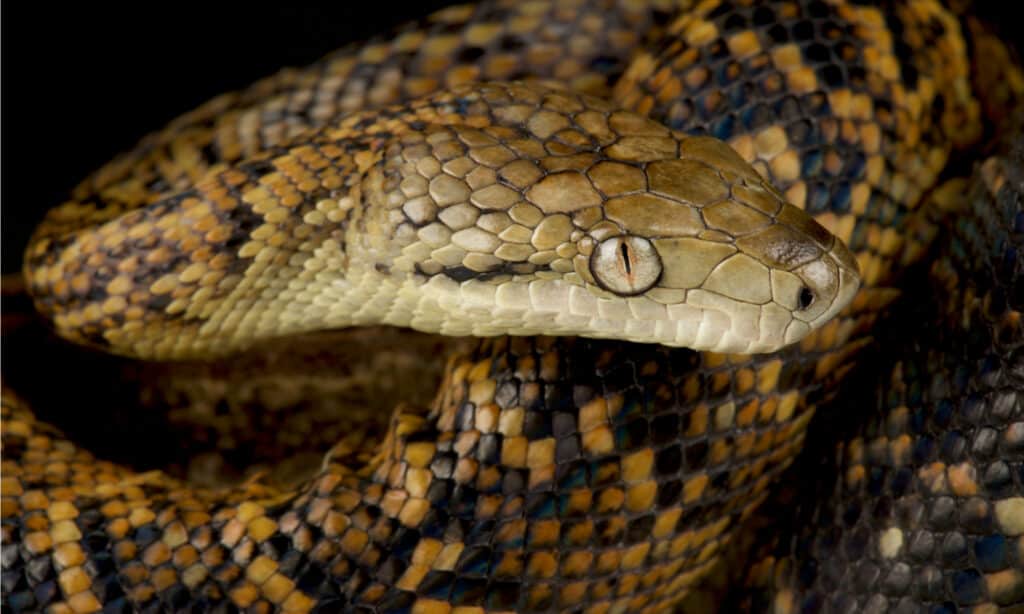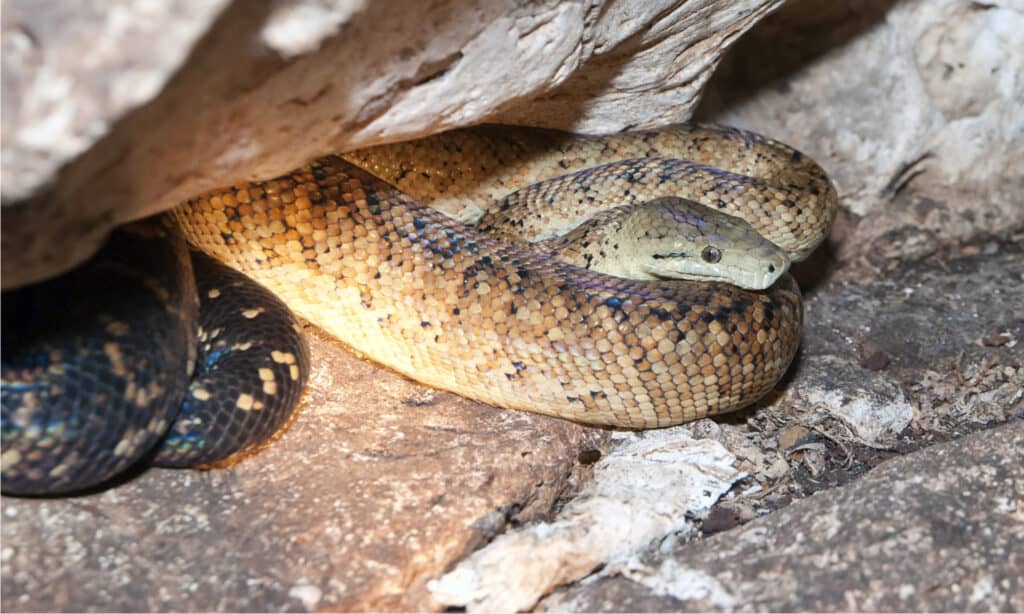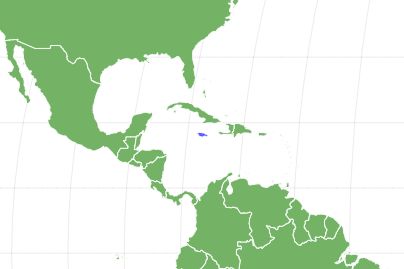Jamaican Boa
Chilabothrus subflavus
When a Jamaican boa is coiled up, it almost looks like two snakes together because of color pattern.
Advertisement
Jamaican Boa Scientific Classification
- Kingdom
- Animalia
- Phylum
- Chordata
- Class
- Reptilia
- Order
- Squamata
- Family
- Boidae
- Genus
- Chilabothrus
- Scientific Name
- Chilabothrus subflavus
Read our Complete Guide to Classification of Animals.
Jamaican Boa Conservation Status
Jamaican Boa Facts
- Prey
- mice, rats, bats, birds, eggs
- Main Prey
- Rats and mice
- Name Of Young
- neonates
- Group Behavior
- Solitary except during mating season
- Fun Fact
- When a Jamaican boa is coiled up, it almost looks like two snakes together because of color pattern.
- Biggest Threat
- People who kill it out of fear, and habitat destruction.
- Most Distinctive Feature
- Greenish-yellow color deepening to pitch-black.
- Other Name(s)
- Yellow snake
- Gestation Period
- 5-6 months.
- Litter Size
- 4-20
- Lifestyle
- Nocturnal
- Favorite Food
- Rats
- Origin
- Jamaica
View all of the Jamaican Boa images!
The largest native predator on the island of Jamaica is a snake – the Jamaican Boa.
This snake often reaches seven and a half feet long. It’s nonvenomous, and a member of the boa family. It used to be widespread across Jamaica, but now only lives in isolated pockets scattered about the island.
Amazing Facts About Jamaican Boas
- They like to hang from tree limbs and cave ceilings to grab bats and birds from mid-air.
- This snake has an interesting color shift from greenish-yellow in the front to pitch-black in the back half.
- Jamaican boas have long, sharp teeth they use to grab prey.
Where to find Jamaican Boas
The Jamaican boa is another species that you can only find in one place in the world: Jamaica! On the island, the locals call this boa the yellow snake.
This snake spends almost all of its time in the trees. It eats rats, bats, lizards, frogs, and small birds at night. Yes, it’s nocturnal. If you’re afraid of snakes, don’t worry about this one. It’ll take care of your rodent problem. Like other snakes, it’s an opportunistic carnivore. However, this dietary flexibility can get it into trouble because it’s susceptible to poisoning by eating the invasive cane toad. The cane toad is one of several species introduced in the 1800s to try to control the rat population.
At night, the Jamaican boa often hangs from tree limbs and crevices in cave walls to snatch flying prey right out of the air. The snake grabs the animal with its razor-sharp teeth and quickly wraps it in its coils to subdue it before swallowing it whole.
Between February and April, during the rainy season, Jamaican boas go looking for a mate. The female carries the eggs while the embryos develop until they’re ready. A female can give birth to between five and 44 babies, which usually measure about 19 inches long.
Jamaican Boa Scientific Name
Like many other species, the Jamaican boa’s scientific name has changed a few times. Actually, more than a few. At this moment, Chilabothrus subflavus is its name. The Chilabothrus genus contains several of the West Indies boas and originates in Greek with “cheilos,” meaning lip, “a,” meaning without, and “bothros,” which means pits. Its specific epithet, subflavus, is Latin and means yellow.
Population and Conservation Status of the Jamaican Boa
The population of the Jamaican boa is relatively small and fragmented. It still exists in the wild in isolated pockets, but it is not widespread across the island anymore. Because of this, the IUCN added it to the Red List of Threatened Species in 2015 as a “Vulnerable” species.
Several factors contributed to this, and one of the first threats it faced was the various introduced species. First, the rats came with sailors who originally traded with Jamaicans for sugar cane and other items. Then, in a futile attempt to control the rats, people introduced the cane toad, European polecat, and carnivorous ants from Cuba. As with other species, the boas appear to be sensitive to the cane toad’s poisonous secretions.
Finally, in 1872, when all the other ideas had failed, they brought in one more animal – the small mongoose (Herpestes javanicus). They ended the experiment ten years later, with disastrous effects. The mongoose did indeed reduce the rat population, but it also caused the destroyed the population of several native bird and reptile species and decimated the boa.
The biggest threat it currently faces is habitat destruction because Jamaican land is constantly cleared for agriculture and timber harvesting. However, another unfortunate problem is that people mistake it for a venomous snake and often kill it on sight.
To help the Jamaican boa survive, the Association of Zoos and Aquariums created a Species Survival Plan to breed the snake in zoos around the world.
Identifying the Jamaican Boa: Appearance and Description
Jamaican boas are medium-sized boas endemic to Jamaica and the Goat Islands. It is a thick-bodied, nonvenomous constrictor that uses its razor-sharp teeth to grab its prey, and strong body to subdue it. Most individuals range in length from 4.9 to 7.2 feet long, although there have been reports of 7.5 to eight-foot-long specimens. This species is arboreal and preys on a variety of game. Rats, juvenile mongooses, bats, birds, lizards, and amphibians are all part of its regular diet.
Its chin and head are often greenish-yellow. It has thin stripes that extend from behind its eyes towards its neck. These snakes vary from pale yellow or tan to orange on the dorsal side with black banding that starts about halfway down the body. Direct sunlight gives it a beautiful iridescence, especially as you approach the back half of its body – the Jamaican boa’s black scales shine with blue, green, and purple.

A nonvenomous species endemic to Jamaica, this snake is not aggressive.
©reptiles4all/Shutterstock.com
Pictures and Videos of Jamaican Boas

While locals call it a yellow snake, it’s only half-yellow. It changes to black in the last half of its body.
©Marcin Sylwia Ciesielski/Shutterstock.com

A nonvenomous species endemic to Jamaica, this snake is not aggressive.
©reptiles4all/Shutterstock.com
How Dangerous is a Jamaican Boa?
It isn’t dangerous. Of the seven extant species in Jamaica, not one is venomous. The most a boa of this size can do to you is bite you with its razor-sharp teeth. However, it is a pretty docile species; the only reason it would bite is if it were threatened or startled in some way.
The only creature this boa is dangerous to is its prey – rats, bats, and birds.
Jamaican Boa: Behavior and Humans
Many people in Jamaica are terrified of snakes. Some are taught from an early age that snakes are bad and that these boas are venomous. Nothing could be further from the truth, because these nonvenomous legless helpers are a farmer’s best friend. However, due to the early teaching, farmers do not always know how beneficial snakes are to their crops and kill any snake they see on sight.
The Windsor Research Centre works to educate the public about this and other snakes native to the island. They have several education programs that actively show people that boas are quite gentle when handled properly and that snakes in general are vital to the balance of the environment. Through their work, and that of others, the beautiful Jamaican boa has a chance for survival.
View all 36 animals that start with JJamaican Boa FAQs (Frequently Asked Questions)
Are Jamaican boas dangerous?
No! They are fantastic to have around. If you live near these snakes, they will take care of your rat problem.
What do they eat?
They’re opportunistic, but mainly they like to eat rodents and birds.
How do they hunt?
Jamaican boas mainly wait to ambush their prey, but some have been known to get into birds’ nests to hunt.
Where do they live?
Only on the island of Jamaica, and there may still be a few on Goat island, which is just to the southeast of Jamaica.
Are Jamaican boas aggressive?
No. The only reason these snakes bite is out of fear or to defend themselves.
Thank you for reading! Have some feedback for us? Contact the AZ Animals editorial team.
Sources
- Reptile Database / Accessed May 12, 2022
- Newman, et al; Review of the Jamaican Boa (Chilabothrus subflavus): Biology, ecology, and conservation management of a vulnerable species / Published August 31, 2020 / Accessed May 12, 2022
- Jamaican Boa | Tulsa Zoo / Accessed May 13, 2022
- Toronto Zoo / Accessed May 13, 2022


















